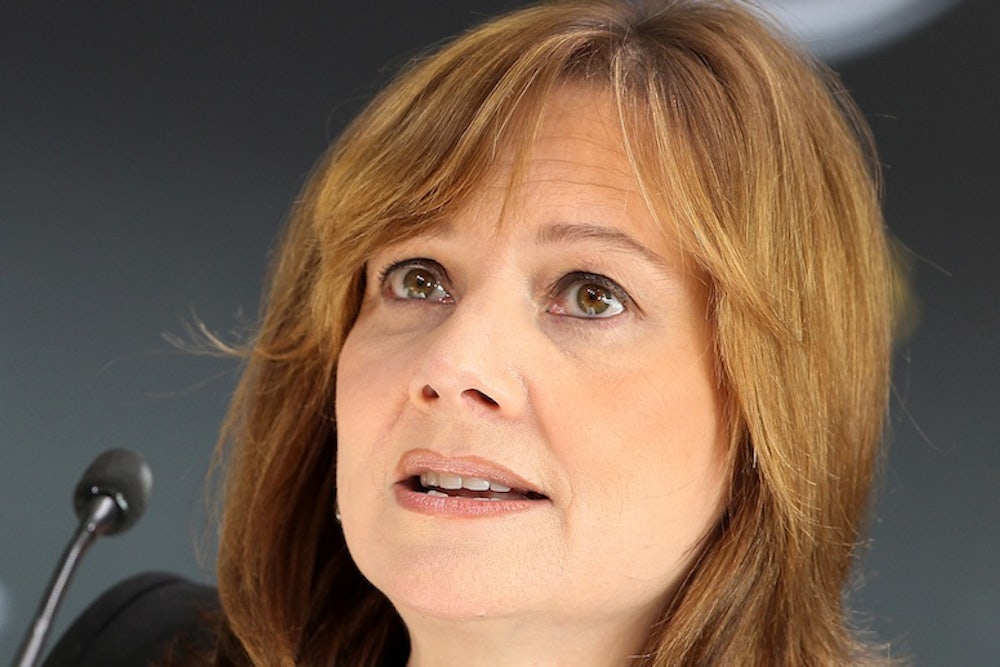In the past few days, Mary Barra, the new CEO of General Motors and the first ever female CEO of a major car company, has morphed from a symbol of success to an embodiment of the fact no amount of ambition and labor guarantees a woman equal treatment.
After President Barack Obama used Barra’s story to illustrate the still-kicking American Dream in his State of the Union Speech, Fox Business decided to look into her compensation at GM—and found it had been set at less than half her predecessor’s. The story turns out to be a little more complicated: As CNN Money reported, Barra’s announced compensation may be $4.4 million, less than half what the last CEO, Dan Akerson, received ($9.1 million), but that’s because GM hasn’t yet announced the “long-term” part of her package (which will likely consist in stocks that shareholders will vote on this spring). GM has since said those numbers will “likely will dispel any notion of pay inequity.” I guess we’ll have to wait and see.
Barra’s short-shrift hit a nerve because the wage gap between men and women is a persistent problem—one that is starkest at the bottom and the top of the income spectrum, making it both deeply harmful and highly visible.
At the top, the numbers have refused to budge for years. Less than 15 percent of Fortune 500 CEOs are women—a figure that represents zero growth over 2009—and those who manage to reach the pinnacle are not paid as well as men. As Bryce Covert writes at The Nation:
The highest-paid female executives at S&P 500 companies make 18 percent less than men in the same position. The gender wage gap among CEOs, in fact, is 69 percent, a bigger gap than that average for everyone. Barra isn’t the only one. Heather Bresch, the CEO of the pharmaceutical company Mylan, makes 33 percent less than what the average chief pharma executive can expect. Denise Morrison, CEO of Campbell Soup, makes 24 percent less than the average in the food industry.
When GM was first asked about the pay gap, a spokesperson pointed out that Akerson had previous experience as a CEO at other companies, while Barra, who came up GM's internal ranks, did not. But the experience of her female peers suggests that she would have been underpaid in prior CEO gigs, too—and would still have arrived at GM without the leverage to achieve a man’s going rate.
Of course, in the most meaningful sense, Barra is not suffering. The lack of an equitable wage is just as ubiquitous, and far more painful, for women at the opposite end of the income ladder. As many have mentioned during Obama’s push to raise the minimum wage to $10.10, two-thirds of people making the current $7.25 wage are women, as are nearly two-thirds of workers in jobs that pay $2.13 an hour, plus-tips. Experts debate the accuracy of the oft-cited figure that women make 77 cents to a man’s dollar. What’s less controversial, though, is that the disparity that number seeks to capture has barely improved in the past decade. And it’s much worse for women of color: If white women make 77 cents to the dollar, black women make 64 cents to a white man’s dollar, and Hispanic women make 55.
The gap isn’t reserved for women at the bottom and top: It persists throughout the middle. In fact, the more education a woman completes, the larger the gap, and it grows from the beginning of a woman's career to the middle. There the causes get a little fuzzy. As Hanna Rosin of Slate has written, “If this midcareer gap is due to discrimination, it’s much deeper than ‘male boss looks at female hire and decides she is worth less, and then pats her male colleague on the back and slips him a bonus.’ It’s the deeper, more systemic discrimination of inadequate family-leave policies and childcare options, of women defaulting to being the caretakers.” It’s also because jobs more frequently held by women—teacher, social worker—pay less than jobs more frequently associated with men. Unlike the minimum wage, this value-perception gap doesn’t have a clear policy fix.
It's hard to muster too much sympathy for a woman pulling in $4 million a year. But, in at least a general sense, Barra's problem is every American woman's problem—magnified by a larger sum.
